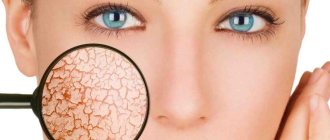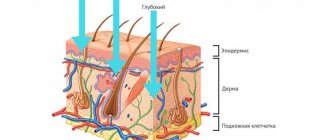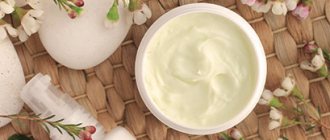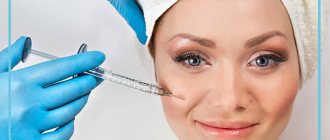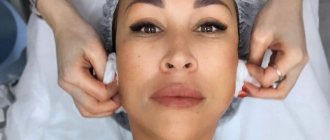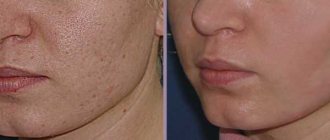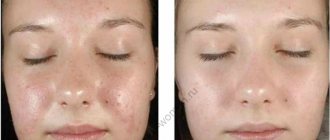You have chosen a gentle peeling
Or rather, a gentle peeling has been chosen for you if you are carrying out the procedure in a salon. Let us explain why this happens.
Aesthetic medicine, which tries to make a woman young and beautiful regardless of age, does not have standard solutions or universal recipes. The specialist (if he is a professional) will definitely take into account all the individual characteristics of the client.
The first visit to the salon for chemical facial cleansing always involves a gentle procedure. This is why there is no peeling after peeling.
The second position - products based on glycolic and fruit acids were used. Such procedures are classified as superficial; they do not affect the deep layers of the epidermis (and even more so do not affect the dermal tissues). The peeling of dead cells can be so slight that it is simply not visible to the naked eye.
The third position is a modern modified exfoliant. The products are designed in such a way that they do not have an aggressive effect on the skin, but remain no less effective. Therefore, there will be no peeling.
Glycolic peeling with salicylic acid
Superficial chemical peeling based on ά- and β-complex - a combination of AHA (40% glycolic acid) and BHA (2% salicylic acid). The basis of the drug is isopropyl alcohol, which has powerful keratolytic and degreasing properties, as well as a specific odor. The procedure is carried out using conventional glycolic peeling technology, however, it is possible to obtain a targeted frost effect due to the more aggressive penetration of Keratopeel, pH 1.4, into the skin. Glycolic peeling with salicylic acid.
Indications for use:
- Hyperkeratosis;
- Photoaging;
- Fading skin;
- Preparation for other types of peeling (for example, retinoic).
Advantages
It has a high penetrating ability and a pronounced exfoliating and stimulating effect.
Keratopeel, pH 1.4
A preparation for superficial chemical peeling based on the alpha & beta complex - a combination of AHA (glycolic acid 40%) and BHA (salicylic acid 2%). Due to the rather high content of glycolic acid in combination with the low pH of the composition, KERATOPEEL has a stimulating effect on the dermis, activating the synthesis of collagen and glycosaminoglycans. Salicylic acid is a well-known keratolytic that enhances the penetration of glycolic acid and has a pronounced proliferative effect. The basis of the drug is isopropyl alcohol, which has excellent keratolytic and degreasing properties. The technique of this peeling, as an independent procedure, is not much different from the usual GLYCOLICPEEL, however, it should be taken into account that, due to its properties, KERATOPEEL penetrates the epidermis more aggressively. It is possible to obtain a spot frost effect.
In addition, KERATOPEEL can be used as a keratolytic agent during the retinoic peeling procedure Block Age Peel Cream to ensure good penetration of retinoids in rough skin with severe signs of hyperkeratosis. In this case, the exposure time of KERATOPEEL on the skin should not exceed 15-20 seconds, after which the composition is neutralized using a neutralizer (Neutralizator). The patient washes, the skin is dried and then Block Age Peel Cream is applied according to his protocol. Glycolic peeling with salicylic acid.
Benefits of peeling
- Has high penetrating ability
- Has a pronounced exfoliating and stimulating effect
- It has a bacteriostatic and comedolytic effect.
Indications for use
- Hyperkeratosis
- Photoaging
- Fading skin
- Preparation for other types of peeling (for example, retinoic peeling)
Contraindications
- Individual intolerance to peeling ingredients
- Violation of the integrity of the skin
- Active inflammatory process on the skin
- Herpes in active phase
- Pregnancy and lactation
Preparations for pre-peeling preparation and post-peeling period for home use
- Cleanser Mousse and Gentle Cleanser Mousse
- Prepeel Light cream (or Prepeel Medium, Prepeel Active)
- Vegefarma Revitalizing Cream
- Post-peel cream Postpeel Light (or Postpeel Medium, Postpeel Active)
- Sunscreen Mediscreen spf 85
Keratopeel peeling protocol
Pre-peeling preparation
For 14–21 days, the patient should apply Prepeel Light cream at night to the facial skin previously cleansed with Cleanser Mousse. Depending on the indications, Prepeel Medium or Prepeel Active creams can be used. In the morning, apply Mediscreen spf 85 sunscreen.
Post-peeling care
For the first 1-2 days after the procedure, the patient should use Vegefarma moisturizing cream (for normal to dry skin) or Vegelip (for oily skin), and Mediscreen sunscreen in the morning.
Expected reactions after peeling:
- Erythema, which can last from several hours to one day;
- Peeling of the skin for 2–4 days after the procedure.
Glycolic peeling with salicylic acid/
Peeling has already passed
The absence of unpleasant dry flakes, which scare women the most, is possible not only when performing facial peeling with a gentle composition for the first time.
Women who regularly take care of their appearance and carry out cosmetic procedures in a salon or at home achieve amazing results. That is, the keratinized skin particles are so small, and the epidermis itself is pliable and susceptible to influence, that the upper dead layer is removed when the working composition is removed. Consequently, during the post-peeling period, skin peeling is not observed at all, or is very mild.
Medium peeling
Medium peeling is a more aggressive type compared to superficial peeling. It acts on the dermis, causing damage to the structure of the skin, aimed at starting the process of regeneration and collagen synthesis. It begins to be actively produced due to the skin’s protective reaction to aggressive factors, in our case a chemical burn.
If peeling is carried out by an experienced doctor, the skin is evened out, its tone and turgor are significantly increased, age-related changes are eliminated, and a lifting effect is noticeable.
Solved problems:
- Smoothing wrinkles (photo- and bioaging);
- Hyperpigmentation;
- Keratosis;
- Acne;
- Scars and scars after acne;
- Fading skin of the hands, neck, décolleté;
- Alignment of skin relief.
Kinds
TCA peeling
— peeling based on trichloroacetic acid. The most commonly used medium peeling. Created to correct skin defects such as scars, acne scars, stretch marks (striae), as well as age-related skin changes. After a course of procedures, skin indicators such as turgor and color improve significantly. Wrinkles are smoothed out, and age spots on the hands, face and neck disappear.
Jessner peeling
got its name in honor of the American doctor Max Jessner, who came up with a unique solution based on resorcinol, lactic and salicylic acids, aimed at exfoliating dead cells. In the USA, this type of peeling is called “Hollywood” because it actually gives brilliant results. It is designed to fight the signs of skin aging, tightens pores with severe oiliness. When added to the composition of depigmenting ingredients (kojic acid, hydroquinone, citric acid), it copes well with melasma and hyperpigmentation.
Procedure
The procedure is performed on the face, décolleté, neck, and arms. Medium peels require accuracy from both the doctor and the patient. It is advisable to use this type of peeling in the autumn-winter period, due to the fact that if exposed to ultraviolet radiation after the procedure, you may not get rid of hyperpigmentation, but will get it strengthened.
The session lasts 15-20 minutes. The cosmetologist sequentially, layer by layer, applies acid to the treated area. During the doctor's action, the patient may feel a significant burning sensation. For several days after chemical peeling, the skin will be tightened, and then active peeling will begin. In general, the recovery period after medium peels lasts from 7 to 14 days.
Despite the fact that the effect of medium peeling can be observed almost immediately after the first session, experts still recommend taking a course consisting of 3-5 procedures, depending on individual skin parameters.
Contraindications:
- Pregnancy and lactation;
- Skin diseases and injuries;
- Oncological diseases;
- Hypertonic disease;
- Epilepsy;
- Individual intolerance to the components of the drug;
- Dry thin skin.
The time for peeling has not yet come
The skin after peeling does not begin to peel off “this very second and now.” A certain amount of time must pass before this process begins. As a rule – 2-3 days.
At first, the face becomes a darker shade, then the upper ball begins to crack slightly and the keratinized particles begin to separate with varying degrees of intensity. This depends on several factors:
- depth of influence. Superficial peeling will not cause a particularly strong reaction and only slight peeling will be noticeable. The middle version of the impact involves the detachment of significant flaps of skin. The pieces look like dry, thin parchment. Under no circumstances should they be forcibly removed or scrubs used for these purposes. Deep peeling is a procedure performed only in a hospital setting and the rehabilitation period is characterized by very severe peeling, reminiscent of “molting”;
- exfoliant used. We have already mentioned this factor. The more aggressive the agent, the more pronounced the process will be;
- pronounced hyperkeratosis or the first procedure in many years. In this case, peeling will not happen, since your skin needs more extensive intervention to remove a sufficiently large number of dead scales that have accumulated over previous years or due to the individual characteristics of the epidermis.
Let us especially dwell on the fourth factor.
Face after Fraxel
The skin after Fraxel will become younger even after one procedure. After fractional photothermolysis, the tone improves, the microrelief is leveled, and fine wrinkles disappear. Excellent results can be achieved in the fight against pigmentation, freckles, and scarring after acne.
You will see all this already 3-7 days after the procedure, but in the first days, most likely, you will have to be patient a little. Swelling after Fraxel is possible, but lasts no more than 1-2 days. Hyperemia (redness) and peeling of the skin persist a little longer, and the severity of these symptoms varies widely.
Peeling after fractional laser is explained by the intensive renewal of the stratum corneum of the epidermis. The superficial thulium laser promotes the exfoliation of dead keratinocytes and accelerates the regeneration of the surface layer of the skin. It takes seven days to completely renew the epidermis, but the peeling goes away by the third or fourth day.
The face may “burn” after Fraxel, and this is a normal reaction. After Fraxel re:fine this symptom is practically absent, after Fraxel re:store DUAL it is mild and lasts for a couple of days. After Fraxel re:pair, patients often complain of a burning sensation comparable to the sensations after sunburn.
You have a special skin type
There is such a thing as “resistant epidermis”. People with this skin type are naturally resistant to damage. The face does not blush, and during the procedure of chemical cleansing and rejuvenation there are no uncomfortable sensations in the form of burning or tingling. These lucky ones are not prone to allergic manifestations.
In this case, it is very difficult to “exfoliate your face” with peeling. Unless it's deep. However, we cannot talk about the uselessness of cosmetic procedures. It’s just that the reaction to exposure by workers is somewhat different from the usual.
What will cosmetologists say?
Experts say that those with oily skin types most often report a lack of peeling after chemical peeling. The reason is simple - the sebaceous secretion binds the keratinized particles and they either “fly off” during the removal of the composition, or a more thorough cleansing is required with a repeat procedure at least two weeks later.
After yellow peeling, there is no peeling in people with special skin types (we have already talked about them). Also, a similar reaction can be observed if the treatment is not retinoic (using retinoic acid), but retinol (using vitamin A and its natural derivatives). The second option is softer, more gentle, providing only a superficial effect on the epidermis. But it is less effective.
Salicylic peels may also not cause peeling in people with oily skin or low acid concentrations. Although this type of procedure is considered a very good preparation before more aggressive influences. Salicylic acid in the composition of the product very well loosens the upper stratum corneum. However, the manipulation needs to be done a week and a half before the “heavy artillery”.
Detachment of epithelial cells occurs imperceptibly when using the “correct” cosmetic products in the post-peeling period and following post-care rules.
Even if the skin does not peel off, cosmetologists advise:
- wash your face after chemical exfoliation with any composition the next morning. For these purposes, it is recommended to use cleansers with a neutral pH (not soap! – it dries). Thermal water or regular mineral water without gas will do;
- Do not use decorative cosmetics for 3-4 days. The effect of peeling will be more pronounced;
- during the entire rehabilitation period (the full recovery cycle ranges from 7 to 14 days) do not use scrubs, other peelings, alcohol-based tonics, cleansing wipes and similar products;
- also during this time do not visit places with high temperature and humidity - saunas, baths, swimming pools, beaches;
- do not sunbathe in the sun or go to the solarium for at least a month;
- even in winter, before going outside, apply a protective cream with a UV factor of at least 30 to your face;
- For the first three days, lubricate your face with panthenol-based creams at night. Next, regularly use moisturizers in the morning and nourishing products at night. Select caring cosmetics according to skin type and age.
Note. Cosmetologists recommend doing chemical peels during the season of least solar activity - from October to April. The sun can provoke the appearance of even greater pigmentation if you do not use sunscreen, or the protection index is insufficient.
How peelings work
The winter period with low solar activity is traditionally considered in our region to be the season for peeling procedures. Taking advantage of the lack of active summer sun, cosmetologists carry out the most aggressive procedures, after which your face swells, sometimes even hurts, and then for another week you change your skin like a snake.
Very often, post-peeling skin irritation is perceived negatively by clients, which is understandable. However, it is worth understanding that in the case of medium and deep peels, it is inflammation that is key to the rejuvenation process. We will look at the stages of this wonderful update. But first, I’ll tell you what kind of peelings there are.
Types of peelings
Superficial peels
act on the stratum corneum. With their help, you can improve the texture of your skin, making it look younger. This is the most popular type of peeling today. The main agents here are the famous ANA and BHA acids.
Medium peels
affect the epidermis, i.e. living layers of cells down to the dermis. These include retinoic, TCA (trichloroacetic acid 10–40% acid), Jessner peel. Such peels are used for pronounced signs of aging, wrinkles of medium depth, loss of turgor, tired face, etc.
Deep peelings
- phenol and peeling with trichloroacetic acid (concentration more than 50%) - penetrate even deeper, this is the most aggressive procedure, causing necrosis of the epidermis and dermis. It is recommended to do such procedures once every few years.
Acidic (with acids) peels change the pH in the stratum corneum, which activates the work of proteolytic enzymes. As a result, desquamation occurs, i.e. accelerated exfoliation of the stratum corneum.
Retinoic (yellow) peeling works according to a slightly different scheme; in this case, acidification does not occur; retinoids directly affect the maturation of living cells, which begin to divide faster and move upward faster, thereby pushing “old” cells to leave the stratum corneum faster. That is why after such peelings the skin does not “flake” but “comes off in layers.”

